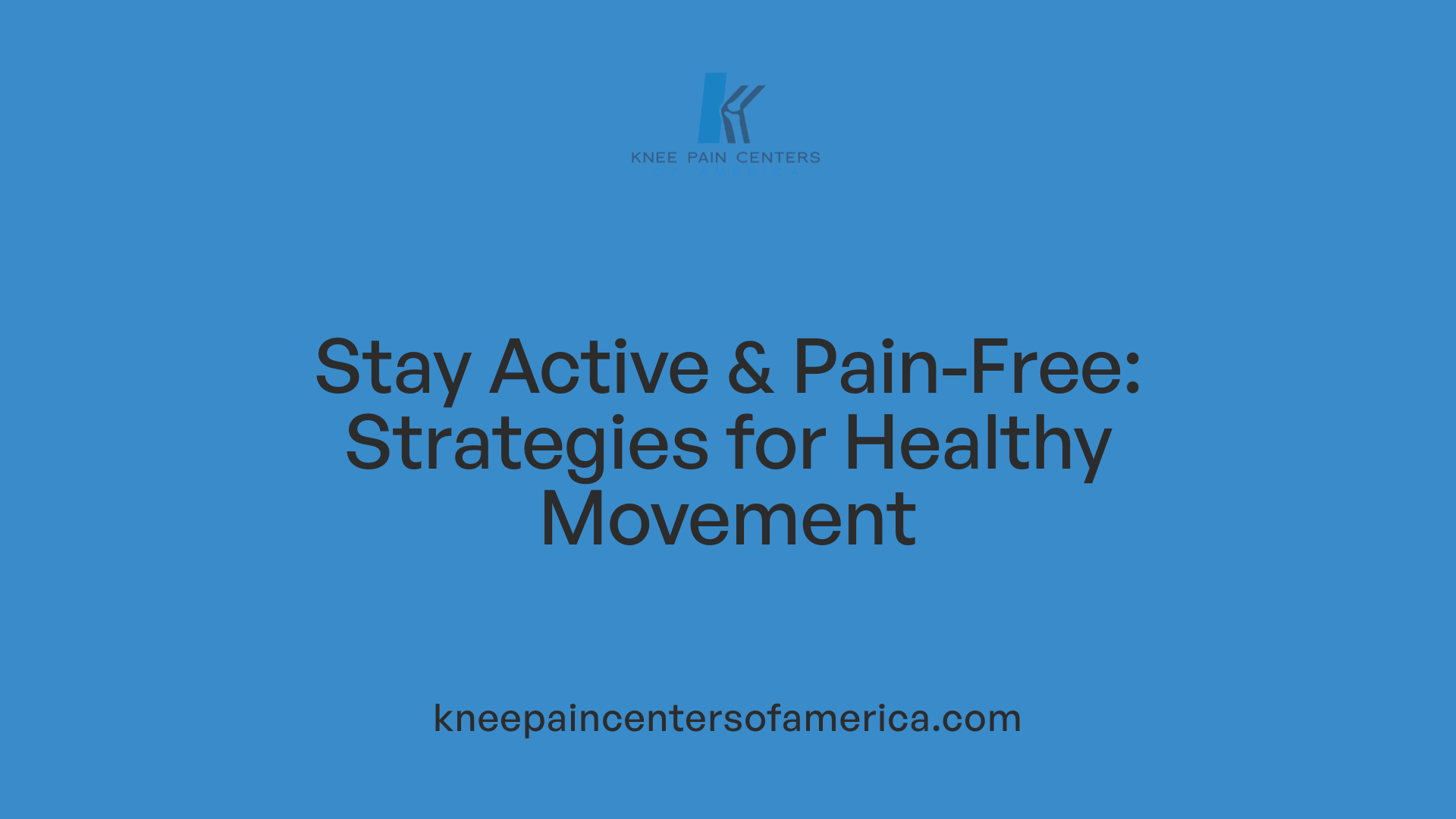Take Control of Your Osteoarthritis Care
Living with osteoarthritis requires more than just coping—it's about actively participating in your treatment journey. Self-advocacy is essential for ensuring you receive the best possible care, understand your options, and make decisions aligned with your needs. This guide offers practical strategies to empower you to communicate effectively with healthcare professionals, stay informed about treatments, and advocate within the broader healthcare system, policy arenas, and your community.
Understanding Osteoarthritis and Building Your Knowledge Base

What is osteoarthritis?
Osteoarthritis is a common joint condition characterized by the breakdown of cartilage, which cushions the ends of bones in your joints. Over time, this deterioration causes bones to rub against each other, leading to pain, stiffness, swelling, and reduced mobility.
What are the common symptoms and signs?
People with osteoarthritis often experience joint pain that worsens with activity and improves with rest. Stiffness, especially in the morning or after periods of inactivity, swelling, and decreased range of motion are also typical signs. You may notice crepitus, a grating or cracking sensation when moving the joint.
How does osteoarthritis progress and affect daily life?
As osteoarthritis advances, pain and stiffness can interfere with daily activities like walking, dressing, or cooking. Over time, joint deformities or misalignments may occur, leading to further disability. Managing symptoms early and with proper care can slow progression and maintain quality of life.
Treatment options and self-care strategies for osteoarthritis
| Treatment Method |
Description |
Additional Details |
| Medications |
Acetaminophen, NSAIDs, corticosteroid injections to relieve pain and inflammation |
Use under healthcare supervision; NSAIDs may have side effects like stomach upset or cardiovascular risks |
| Physical therapy |
Exercises to improve joint flexibility and strengthen surrounding muscles |
Guided by professionals; includes stretching, resistance training, and modalities like TENS |
| Weight management |
Losing excess weight to reduce joint load and slow disease progression |
Diet and exercise are key; even small weight reductions can significantly lessen joint stress |
| Low-impact exercises |
Walking, swimming, Tai Chi, yoga to support joint health and reduce stiffness |
Consistent activity helps maintain mobility and muscle strength |
| Supportive devices |
Braces, taping, canes, orthoses to stabilize joints and reduce pain |
Proper use can prevent further joint damage and improve function |
| Heat and cold therapy |
Heat to relax muscles, cold to reduce swelling and inflammation |
Use carefully to avoid skin damage; suitable based on symptoms |
| Surgical interventions |
Joint replacement or realignment when conservative treatments fail |
Reserved for severe cases and assessed by orthopedic specialists |
Additional info
Understanding osteoarthritis and its management involves combining medical treatments with lifestyle changes. Regular physical activity, weight management, and patient education are crucial components. Always consult healthcare professionals to tailor a plan suited to your needs.
By staying informed and proactive, you can take control of osteoarthritis, minimize its impact, and maintain a good quality of life.
Self-Management and Lifestyle Modifications for Joint Health

How can I educate myself about osteoarthritis and its various treatments?
Gaining a thorough understanding of osteoarthritis and how to manage it involves accessing reliable, research-backed information. Start by consulting trusted healthcare sources such as the Arthritis Foundation, Johns Hopkins Rheumatology, and the CDC. These organizations offer educational materials, including brochures, videos, webinars, and online programs like 'Walk With Ease' and Tai Chi for Arthritis, which are designed specifically to support self-management.
Exploring professional guidelines from the American College of Rheumatology provides up-to-date standards of care and treatment options. Reading scientific articles in peer-reviewed journals like Arthritis & Rheumatology can further deepen your knowledge of emerging treatments and research findings.
Participating in community programs and support groups can also be invaluable. These often provide workshops and classes on lifestyle modifications, including exercise routines, weight management, and injury prevention.
Furthermore, digital resources such as instructional videos, online toolkits, podcasts, and social media groups provide accessible ways to learn and stay connected with others managing arthritis. By combining these sources, you can develop a comprehensive understanding of osteoarthritis, empowering you to make informed decisions and advocate effectively for your health.
Physical activity and exercises
Engaging in regular, low-impact physical activity is fundamental for joint health. Activities like walking, gardening, or household chores can support joint function and reduce stiffness. Therapeutic exercises—including stretching, resistance training, and balance exercises such as Tai Chi or Yoga—target muscle strength and flexibility, helping to protect joints and reduce pain.
Weight management and diet
Maintaining a healthy weight decreases stress on load-bearing joints like the knees and hips, helping to slow disease progression and reduce discomfort. Eating a balanced diet rich in vegetables, fruits, and whole grains supports overall health. Though not directly impacting osteoarthritis, limiting saturated fats and sugars can prevent additional health issues.
Additionally, some supplements like Vitamin D, glucosamine, chondroitin, and turmeric may offer benefits, but it’s essential to discuss their use with your healthcare provider.
Use of assistive devices and proper joint positioning
Incorporating assistive devices such as braces, canes, or shoe inserts can relieve joint stress and improve mobility. Proper joint positioning during activities minimizes strain and prevents further damage. Learning correct techniques from healthcare professionals ensures optimal use.
Role of supplements and nutrition
While a nutrient-rich diet supports overall health, certain supplements may provide additional benefits. Vitamin D contributes to bone health, and compounds like glucosamine and chondroitin may support joint cartilage. Turmeric’s anti-inflammatory properties can also help alleviate pain. Always consult your healthcare provider before starting any new supplement to ensure safety and appropriateness.
By actively applying these lifestyle modifications and staying educated, individuals with osteoarthritis can better control symptoms, maintain joint function, and improve their overall quality of life.
Strategies for Staying Active and Managing Pain

What are some strategies for staying active with osteoarthritis?
Maintaining an active lifestyle is crucial for managing osteoarthritis symptoms. Engaging in low-impact exercises like walking, swimming, water aerobics, and cycling can help support joint health without causing excessive stress. Experts recommend aiming for at least 150 minutes of moderate activity each week, which can be broken into shorter sessions to suit your energy levels and schedule.
In addition to aerobic activity, incorporating strength training exercises two to three times weekly can help support and stabilize the affected joints. These exercises can include resistance training or using resistance bands, which strengthen muscles around the joints, reducing pain and improving function.
Daily flexibility routines, such as stretching and range of motion exercises, maintain joint suppleness and prevent stiffness. Practices like yoga, tai chi, and Pilates not only improve flexibility but also enhance balance and mental well-being, which are beneficial for overall health.
To prevent joint overuse and stress, it’s essential to start slowly and listen to your body. Gradually increasing the duration and intensity of activity allows your joints to adapt safely. Consulting with healthcare professionals, such as physical therapists, can help design a personalized activity plan that considers your specific needs and limitations.
Balancing activity with sufficient rest is also important. Rest days help your joints recover and avoid inflammation or fatigue. Wearing supportive footwear, using assistive devices when necessary, and maintaining proper joint posture during activities can further protect your joints.
By adopting these strategies, individuals with osteoarthritis can enjoy the benefits of staying active—such as reduced pain, improved mobility, and better mood—while minimizing the risk of joint damage.
Effective Communication and Appointment Preparation

How can I effectively communicate with healthcare providers about osteoarthritis treatment?
Communicating effectively with your healthcare team is vital for managing osteoarthritis. Start by preparing questions and keeping a symptoms log before your appointment. Write down your concerns, pain levels, mobility issues, and any other symptoms, noting when they occur and their severity. This detailed record helps your provider understand your condition better.
Good communication techniques include being honest and transparent. Share your experiences openly, including how osteoarthritis affects your daily life and what you hope to achieve from treatment. Use simple, clear language and ask your provider to explain diagnoses, medications, and procedures thoroughly. Don’t hesitate to ask for clarification on any confusing medical terms or options.
Using support persons during appointments can be very beneficial. A partner, family member, or friend can help ask questions, take notes, and remember information provided by your healthcare team. Their presence can also offer emotional support during potentially overwhelming visits.
Effective note-taking during visits ensures you retain important details. Bring a notebook or use a recording device (with your provider’s permission) to jot down instructions, medication changes, or follow-up steps. Summarize what was discussed at the end of each appointment to confirm understanding.
Building a positive and collaborative relationship with your healthcare provider involves active listening and shared decision-making. Express your treatment preferences and discuss all available options, including benefits and possible side effects. Follow up on plans and keep communication ongoing. These practices empower you to be an active participant in your osteoarthritis management and lead to better health outcomes.
Preparing for Medical Appointments and Asking the Right Questions

How can I effectively prepare for a medical appointment about osteoarthritis?
Preparing well can make a significant difference in managing osteoarthritis. Start by documenting your symptoms in detail, including when they began, how they change over time, and what activities or factors make them better or worse. Keeping a symptom log can help your healthcare provider better understand your condition.
Make a list of all current medications, supplements, and previous treatments you’ve tried. Include dosages, frequency, and how effective they have been. If you have relevant medical records or imaging results, bring copies to your appointment to provide your doctor with comprehensive information.
It’s also helpful to prepare specific questions about your diagnosis, treatment options, lifestyle changes, and warning signs of worsening condition. Writing these questions down beforehand ensures you don’t forget to address important concerns.
Bringing a support person can be beneficial. They can help you remember details discussed during the appointment and provide emotional support, especially if you’re anxious or overwhelmed.
Be honest with your healthcare provider about your lifestyle factors, such as activity level, diet, and any obstacles faced in following treatment plans. Using tools like symptom trackers or discussion guides can facilitate a clearer and more productive conversation.
Self-Advocacy Techniques and Policy Engagement
How can I advocate for myself in managing osteoarthritis?
Effective self-advocacy starts with becoming well-informed about osteoarthritis and its treatment options. Spending time researching reputable sources like the Arthritis Foundation or Healthline helps you understand your condition, available therapies, and your rights as a patient.
Once equipped with knowledge, clear and confident communication with your healthcare team is crucial. Share your symptoms, concerns, and treatment preferences openly. Prepare questions beforehand and keep track of your symptoms and responses to treatments in a journal. This documentation helps your doctors understand your experience and tailor care more effectively.
Utilizing resources such as the Self-Advocacy Guide can empower you with strategies to navigate healthcare coverage options, understand policy impacts on your care, and advocate for policies that support affordable medication and better access to treatments.
Beyond clinical interactions, engaging at the community level and through social media can amplify your voice. Sharing your personal story can highlight the real-world impacts of osteoarthritis and influence policymakers to support legislation aimed at improving care and access.
At work or school, advocating for reasonable accommodations like flexible schedules or ergonomic adjustments can make daily management easier. Understanding and asserting your rights ensures you maintain your quality of life while managing symptoms.
Building confidence and assertiveness involves practicing effective communication and preparing for interactions in advance. Approach discussions with a clear understanding and a respectful tone, emphasizing your needs and goals.
Communicating needs effectively requires active listening, articulating your concerns clearly, and collaborating with healthcare providers to develop personalized treatment plans. Remember, your experiences and opinions are valid and critical for optimal care.
Engaging in advocacy at local and policy levels involves staying informed about relevant legislation and supporting initiatives like the HELP Copays Act that aim to reduce medication costs. Contacting legislators or participating in policy discussions can help shape health policies that benefit arthritis patients.
Sharing personal stories through support groups, community events, or campaigns can foster greater awareness and empathy. Personal narratives humanize the struggles faced by those with osteoarthritis, encouraging community and legislative action.
Incorporating these advocacy techniques allows you to take charge of your health journey, influence healthcare policies, and foster a supportive environment for others facing similar challenges.
Building Support Networks and Raising Awareness
Connecting with Support Groups
Support groups provide a vital platform for individuals living with osteoarthritis to share experiences, gain emotional support, and exchange practical advice. Joining local or online groups can help patients feel less isolated and empowered to manage their condition. These groups often organize educational sessions, exercise classes, and advocacy campaigns, fostering a sense of community.
Sharing Personal Stories
Personal stories are powerful tools for advocacy and awareness. Sharing how osteoarthritis impacts daily life can influence policymakers, healthcare providers, and the general public. Stories help humanize the condition, dispel misconceptions, and highlight the importance of access to comprehensive care and support services.
Participating in Awareness Campaigns
Engaging in awareness campaigns, such as Arthritis Awareness Month in May, raises public understanding and promotes early diagnosis and treatment. Patients and advocates can participate by wearing awareness ribbons, spreading information through social media, or organizing local events. Such efforts can attract media attention, influence policy changes, and increase funding for research.
Techniques for Active Involvement in Healthcare Decisions
Effective participation involves staying informed about osteoarthritis through reputable resources such as the Arthritis Foundation and the American College of Rheumatology. Patients are encouraged to prepare questions before appointments, communicate openly with their providers, and utilize shared decision-making tools like MILSDM to navigate treatment options.
Clear, honest dialogue builds trust with healthcare teams and ensures that treatments align with personal values and lifestyles. Recognizing systemic barriers and cultural differences is essential, and clinicians can support patient engagement by creating a respectful, inclusive environment. Active involvement in healthcare fosters better adherence to treatment and improves overall health outcomes.
Empowerment Through Knowledge and Action
Self-advocacy is a critical component of effective osteoarthritis management. By educating yourself, preparing for appointments, communicating openly, and engaging in advocacy efforts, you can ensure that your treatment aligns with your needs and that your voice is heard within the healthcare system. Building strong relationships with your healthcare team, staying informed about your condition, and actively participating in decision-making empower you to live well despite osteoarthritis. Remember, your voice matters—take charge of your health today and advocate for the care and resources you deserve.
References